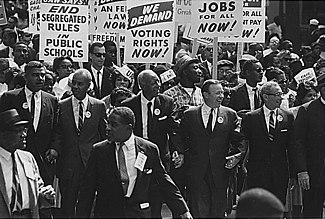African-American Civil Rights Movement (1955-1968)
| African-American Civil Rights Movement | |
|---|---|

The March on Washington participants and leaders marching from the Washington Monument to the Lincoln Memorial
|
|
| Date | 1954–1968 (15 years) |
| Location | United States, especially the Southern region |
| Result |
|
The Civil Rights Movement, also known as the American Civil Rights Movement and other names, encompasses strategies, groups, and social movements in the United States whose goals were to end racial segregation and discrimination against African Americans and to secure legal recognition and federal protection of the citizenship rights enumerated in the Constitution and federal law. This article covers the phase of the movement between 1954 and 1968, particularly in the South.
The movement was characterized by major campaigns of civil resistance. Between 1955 and 1968, acts of nonviolent protest and civil disobedience produced crisis situations and productive dialogues between activists and government authorities. Federal, state, and local governments, businesses, and communities often had to respond immediately to these situations, which highlighted the inequities faced by African Americans. Forms of protest and/or civil disobedience included boycotts such as the successful Montgomery Bus Boycott (1955–56) in Alabama; "sit-ins" such as the influential Greensboro sit-ins (1960) in North Carolina and successful Nashville sit-ins in Tennessee; marches, such as the Birmingham Children's Crusade and Selma to Montgomery marches (1965) in Alabama; and a wide range of other nonviolent activities.
The 1950s and 1960s Civil Rights Movement witnessed the passage of several primary pieces of federal legislation. The Civil Rights Act of 1964, expressly banned discrimination based on race, color, religion, sex, or national origin in employment practices and ended unequal application of voter registration requirements and racial segregation in schools, at the workplace, and by public accommodations. The Voting Rights Act of 1965 restored and protected voting rights for minorities. The Immigration and Nationality Services Act of 1965 removed racial and national barriers and opened the way for non-white immigrants. The Fair Housing Act of 1968 banned discrimination in the sale or rental of housing. African Americans re-entered politics in the South, and across the country young people were inspired to take action.
...
Wikipedia
